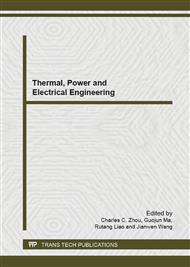[1]
Carreras B A, Newman D E, Dobson I, et al. Evidence for Self-organized Criticality in Electric Power System Blackouts. Hawaii International Conference on System Sciences Hawaii, (2001).
DOI: 10.1109/hicss.2001.926273
Google Scholar
[2]
Cao Yi-jia, Jiang Quan-yuan, Ding Li-jie. Self-organized Criticality Phenomenon for Power System Blackouts. Power System Technology, 2005, 29(15):1-5.
Google Scholar
[3]
YU Qun, GUO Jianbo. Statistics and Self-organized Criticality Characters of Blackouts in China Electric Power Systems. Automation of Electric Power Systems, 2006, 30(2):16-21.
Google Scholar
[4]
Mei Sheng-wei, Xue An-cheng, Zhang Xue-ming. Self-organized Criticality of Power System and security of the grid. Beijing, Tsinghua University Press, (2009).
Google Scholar
[5]
Carreras B A, Newman D E, Dobson I, et al. Evidence for Self-organized Criticality in Electric Power System Blackouts. IEEE Trans on Circuits and Systems, 2004, 51(9): 1733-1740.
DOI: 10.1109/tcsi.2004.834513
Google Scholar
[6]
LEI Ya-Zhou. Studies on Wind Farm Integration into Power System. Automation of Electric Power Systems, 2007, 27(8): 84-88.
Google Scholar
[7]
Xia De-ming, Mei Sheng-wei, Hou Yun-he. A Power System Blackout Model Based on OTS and Its Self-organized Criticality. Automation of Electric Power Systems, 2007, 31(12): 12-18.
Google Scholar
[8]
Yu Qun, Cao Na, Guo Jianbo. Analysis on Influence of Load Rate on Power System Self-orgnized Criticality. Automation of Electric Power Systems, 2012, 36(1), 24-27, 37.
Google Scholar
[9]
Wang Guang-zeng. Research on Complex Power Grid Modeling Based on Complex Network Theory. Hangzhou: Zhejiang University, (2009).
Google Scholar
[10]
He Fei, Mei Sheng-wei, Xue An-cheng et al. Blackouts Distribution and Self-Organized Criticality of Power System Based on DC Power Flow. Power System Technology, 2006, 30(14), 7-12.
Google Scholar
[11]
J. Chen, J.S. Thorp, I. Dobson. Cascading Dynamics and Mitigation Assessment in Power System Disturbances via a Hidden Failure Model. Electrical Power and Energy Systems, 2005, 27:318-326.
DOI: 10.1016/j.ijepes.2004.12.003
Google Scholar
[12]
Ding Li-jie. Research on Analysis and Preventive Control of Cascading Blackouts in Complex Power Systems. Hangzhou: Zhejiang University, (2008).
Google Scholar


